It has been 17 months since Chicago Bulls’ guard Derrick Rose last took to the court after tearing the anterior cruciate ligament in his knee during a 2012 playoff game against the Philadelphia 76ers.
To be exact, he has been out for 526 days. That’s a long time by today’s standards. Hell, that’s a long time by any standards.
Saturday the Bulls’ superstar took to the hardwood for the first time since the injury, scoring 13 points in a little over 20 minutes.
Tearing an ACL while playing sports at an elite level is not uncommon, but what made this particular injury interesting is that it was one of many recent basketball-related knee injuries.
ACL tears are quite common in the brutal ranks of the NFL, but have only reached notoriety on the hardwood quite recently.
Before the 2011-’12 season the last time an active all-star went down with an ACL tear in the NBA was Danny Manning in 1995, following the last NBA lockout.
That’s almost 20 years ago.
Ricky Rubio tore his ACL a month before Rose, and two other NBA players went down with the same injury that April.
Last season there were five total ACL tears in the NBA, with Rajon Rondo being the most notable name on the list.
That makes nine ACL tears in the last two seasons. What changed in the game of basketball that might have caused this large spike?
Many people point to the way the game is progressing. Bigger, faster, more athletic men mean more aggressive cuts and, therefore, more stress on the knees.
Tearing an ACL is as violent an injury as you’ll ever see, and the lateral movement that the modern game of basketball requires puts every player at risk of knee injury.
This is a large part of the equation, yes, but not all of it.
Another event that may or may not have an impact on the number of recent injuries is the 2011 lockout.
Abandoning the 2011-'12 season was probable, meaning players probably failed to prepare for the year in typical fashion.
The lockout also meant less offseason time with expert team trainers who know the specific demands of basketball on the body. A six-month, 66-game schedule only exacerbated the problems presented by unconditioned bodies.
ACL injuries occur when the stabilizing actors of the knee, namely the illiotibial band and the biceps femoris muscle, get fatigued or weak, or when there is a strength imbalance between the vastus medialis and the vastus lateralis muscles, which stabilize as well as rotate the knee.
The reason a football lockout wouldn’t cause a similar spike is the different energy demands football and basketball present to the muscles.
In football players get time between plays to rest, allowing the body to use its preferred fuel, creatine phosphate, to make powerful movements, including stabilization under violent conditions. It also is easier to maintain these muscles during a football season in which there are entire weeks between games.
As a result most of the knee injuries in football are the result of contact, not quick change in directions.
Basketball is constant movement, meaning the body has to resort to using carbohydrate and fat to fuel movements. This means muscles, especially stabilizers that are under constant stress, run a much higher risk of fatigue.
Basketball seasons also cram many games into a short amount of time, meaning muscles get broken down drastically over the course of a year.
The offseason in any sport is vital. People say all the time that year-round seasons would be a good idea.
That’s a horrible suggestion.
When we think about preparation for elite-level athletics it is one thing to be able to sprint for long periods of time and jump high, it is another entirely to strengthen all the little muscles, tendons and ligaments in your legs whose only job is to hold everything in place under extreme energy demands. Training is much more than simply trying to increase combine scores.
Athletics always require time to re-build the body’s parts that get worn down over the course of a season, namely the stabilizing structures that keep joints from popping out of socket and limbs moving in their proper planes of motion.
A single offseason to correct essentially two seasons’ worth of muscle breakdown might not have been enough for the NBA.
That could explain why the trend can be seen past the 2012-’13 post-lockout season.
All this is pure speculation of course, and the progression of the game is only going to continue, meaning more stress on knee joints and more injuries. That much is practically indisputable.
It would be wrong to say that ACL tears will ever disappear from basketball, but hopefully with months of conscious preparation they will cease to plague the NBA this season and into the future.
Brett works for the Division of Recreational Sports as a personal trainer, and last semester wrote more extensively on sports injuries in his column on the Life & Style page. How much of an impact do you think the lockout caused on the NBA’s injury rates? Should Brett have failed anatomy and physiology? Email sports@dailycardinal.com and let him know.





